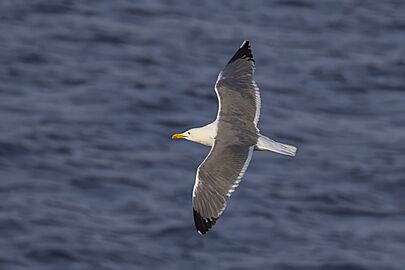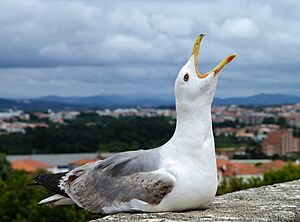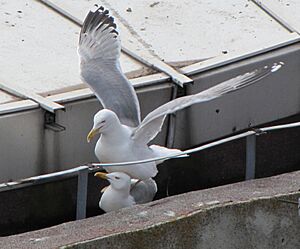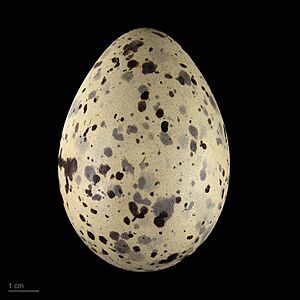Yellow-legged gull facts for kids
Quick facts for kids Yellow-legged gull |
|
|---|---|
 |
|
| Georges-Valbon, France | |
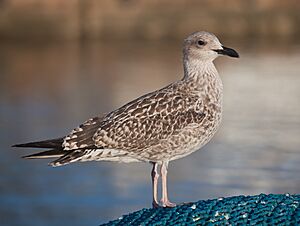 |
|
| Juvenile, Portosín, Porto do Son, Galicia, Spain | |
| Conservation status | |
| Scientific classification | |
| Genus: |
Larus
|
| Species: |
michahellis
|
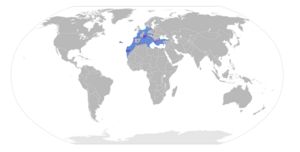 |
|
| Synonyms | |
|
Larus argentatus michahellis Naumann, 1840 |
|
The yellow-legged gull (Larus michahellis) is a large gull that lives in Europe, the Middle East, and North Africa. For a long time, people thought it was just a type of subspecies of other gulls, like the Caspian gull or the herring gull. But now, scientists agree it is its own unique species.
The name Larus comes from a Latin word for a large seabird. The species name michahellis honors a German zoologist named Karl Michahelles.
Contents
About the Yellow-legged Gull
Scientists often group animals into different categories. For a while, there was a lot of debate about whether the yellow-legged gull was a separate species or just a type of herring gull. Now, most experts agree it is its own distinct species.
Types of Yellow-legged Gulls
There are two main types, or subspecies, of the yellow-legged gull:
- L. m. michahellis: This is the most common type. You can find it in western and southern Europe, northwestern Africa, and around the Mediterranean Sea.
- L. m. atlantis: This type lives in the Macaronesia islands, like the Canary Islands and Madeira. It is sometimes called the Atlantic gull. These birds have darker wings and backs compared to those in the Mediterranean.
-
An adult yellow-legged gull flying in Malta.
Where Yellow-legged Gulls Live
These gulls mainly live around the Mediterranean Sea. You can find them in countries like Morocco, Algeria, and Tunisia in North Africa. In the Middle East, they live in places like Israel and Turkey. In Europe, they are found all along the Mediterranean coast and on islands in the Atlantic Ocean. They have also started to spread north into central and western Europe.
Many yellow-legged gulls stay in the same area all year. Others travel to warmer places for winter, like western Europe or as far south as Senegal. Sometimes, they even visit places like North America or Nigeria.
What Yellow-legged Gulls Look Like
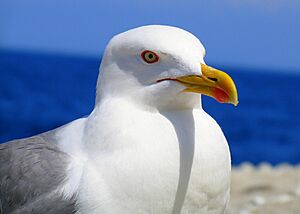
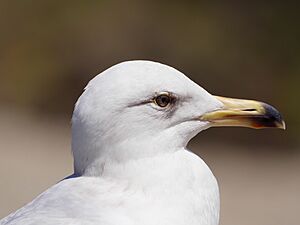
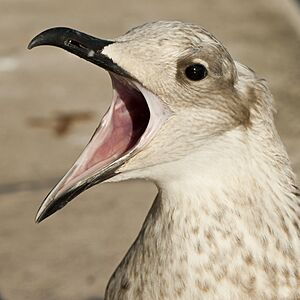
The yellow-legged gull is a large bird. They can be about 52 to 68 cm (20 to 27 in) long and have a wingspan of 120 to 155 cm (47 to 61 in). Their weight can range from 550 to 1,600 g (1.21 to 3.53 lb).
Adult gulls look a lot like herring gulls, but they have yellow legs. Their backs are grey, a bit darker than herring gulls but lighter than lesser black-backed gulls. In autumn, their heads become very white. They have mostly black wing tips with only a few white spots. Like many gulls, adults have a red spot on their bill. They also have a red ring around their eyes.
Young yellow-legged gulls have lighter heads and undersides. Their bills and eyes are dark, and their legs are a pinkish-grey color. They have a clear black band on their tail. By their second winter, they look much more like adult gulls.
Their call is a loud, deep laugh. It sounds more nasal than the call of a herring gull.
What Yellow-legged Gulls Eat
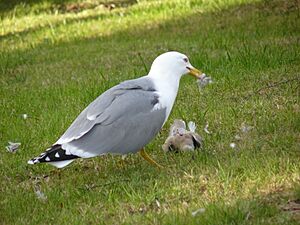
Like most gulls, yellow-legged gulls eat many different things. They are very good at finding food wherever they can. They will eat scraps from rubbish tips or find prey in fields and along the coast. They also sometimes steal food from smaller gulls or other seabirds.
Gulls living in cities often eat food scraps. However, they can also hunt if they need to. For example, during the lockdown in Italy in 2020, there was less food waste. The yellow-legged gulls in Rome started hunting larger prey, like rats and rock doves.
Gulls in Gibraltar have even been seen eating fruit from olive trees while flying!
Reproduction
Yellow-legged gulls usually build their nests in groups called colonies. They typically lay three eggs between mid-March and early May. These gulls are very protective of their eggs.
Their nests are usually simple piles of plants built on the ground or on cliff ledges. In some places, like Gibraltar and Portugal, they have started nesting on buildings in cities or even in trees. The eggs hatch after about 27 to 31 days. The young birds are ready to fly after 35 to 40 days.



